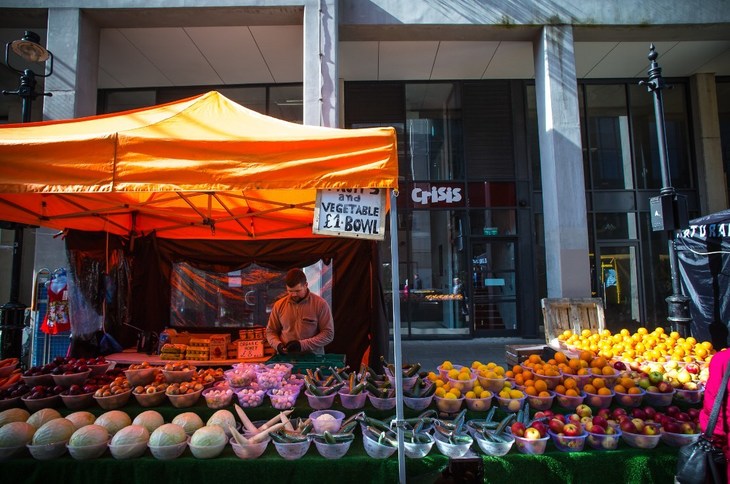
All photos © Lee Townsend
Lionel Bart, the lyricist of old London town, had a line in one of his 1960s musicals that, "They've changed our dancing palais into a bowling alley, and fings ain't what they used to be".
There's change going on down Surrey Street, London's oldest street market, tucked away almost out-of-sight out-of-mind, round the corner from Croydon Town Hall. But as yet, no one really knows what might emerge at the end of the 'regeneration' process. There's a good chance that fings ain't going to be what they used to be.

Saturday, March 25, 2017, could yet go down in the history books as the last time the stallholders packed up at the end of a day's trading, in a street market which traces its history back almost as far as the Domesday Book. If too few of the stalls return, there's a real risk that another slither of old London will have fluttered away on the breeze of someone's notion of improvements and modernisation.
The stalls have been moved away while Croydon Council carries out carriageway works, part of a £1.1m scheme to revitalise a market which may have first existed in Anglo-Saxon times, and for which there is evidence of it operating since 1236 (thanks to being granted charters by various Archbishops of Canterbury through the medieval period).

The Archbishops, at a time when the church was often wealthier and more powerful than the crown, had a summer residence in Croydon, not far from where Surrey Street is today, and at Addington Palace, just up the road. From Robert Kilwardby — who in 1273 granted a charter for a nine-day May fair to be held at the site — and onwards, it was in the bishops' interest to have a thriving market nearby, at a time when Croydon a country market town, rather than a London suburb.
Farmers and herdsmen from Kent, Surrey and Sussex would drive their cattle and sheep up the road from the South Downs for market days in Croydon; there are echoes of that in existing street names — Drovers' Road and Tanfield Road. Before it was renamed Surrey Street, the row of shops, abattoirs and tanners off Croydon's High Street was known as Butcher Row with good cause; the slight slope on the street allowed the blood and other fluids to run away.

Croydon's first Town Hall, from the 18th century, was built at the corner of Butcher Row and the High Street, and served as more of a market house and corn exchange at first. It helped to established the geography of Croydon's town centre. The current Town Hall, in all its late Victorian splendour, was built not so far away.
It was through the 20th century that Surrey Street took on the character that we recognise as a rough-and-ready, no-frills London street market, much like Walworth's East Lane or Waterloo's Lower Marsh. It has a pie and eel shop at one end, a decent old-fashioned boozer in the middle, a couple of bookies nearby, while along the length of the street, fruit and veg traders call out to passing shoppers.

Until recently, their market cry – like "Who will buy?" out of Bart's Oliver! — has been "Pound a bowl!", with the offer of bananas or tomatoes at tremendous value, alongside stalls selling a bewildering variety of Chinese herbs or another with Caribbean spices, plantain and other exotic-looking ingredients.
But among the residents and traders who live and work around Surrey Street, there's a sense of creeping gentrification, as Croydon Council seeks to clean up the market ahead of the long-promised arrival of the £1.4bn Westfield development.

And that stall-holders' cry has changed of late, with the arrival of an artisan baker's stall, to one of "Pound a croissant!"
The market has witnessed reduced footfall and lost nearly half of its stalls in the past decade. One local councillor, overseeing the regeneration plans, has described the market as "tatty", while he has authorised spending £10,000 on a neon street sign designed by an artist whose claim to fame has been to have their work exhibited at the Saatchi Gallery.

For now, at least, that sign now hangs several feet above an empty street, the stalls having been shunted to another pedestrianised area from which, some suggest, they may never return.
"Of course we feel let down," one stallholder says, before packing up on Saturday. "It's the council that allocates the licences for a pitch. I don't want them stopping me working, do I?

"They say they're spending all this money, but on what? Who benefits? What does having a pop-up bar opening up outside the Dog and Bull do to help bring in more shoppers, or do for the pub's business? We've been asking them to put up some proper signs to direct people to the market for years, and yet they can't do something as simple as that."
The threat to trade from a shiny new shopping mall is nothing new: back in 1970, after the Whitgift Centre opened — and where Westfield is expected to start redevelopment work in 2018 — the local paper was full of reports of a downturn in trade for Surrey Street. Nearly half a century on, and the precarious nature of the market trade has not changed.

"Will I go back when the market re-opens?" the trader asks, "I really don't know. It depends on how well we trade for the next few months, and how many other stalls decide to go back. I've seen people, good friends I've worked alongside, come rain or shine for 10, 15 years, just give it up in the last few months.
"This was never a game to get into if you wanted to get rich, but it has got a lot harder to make even a modest living lately."
Down Surrey Street, fings really ain't what they used to be.









